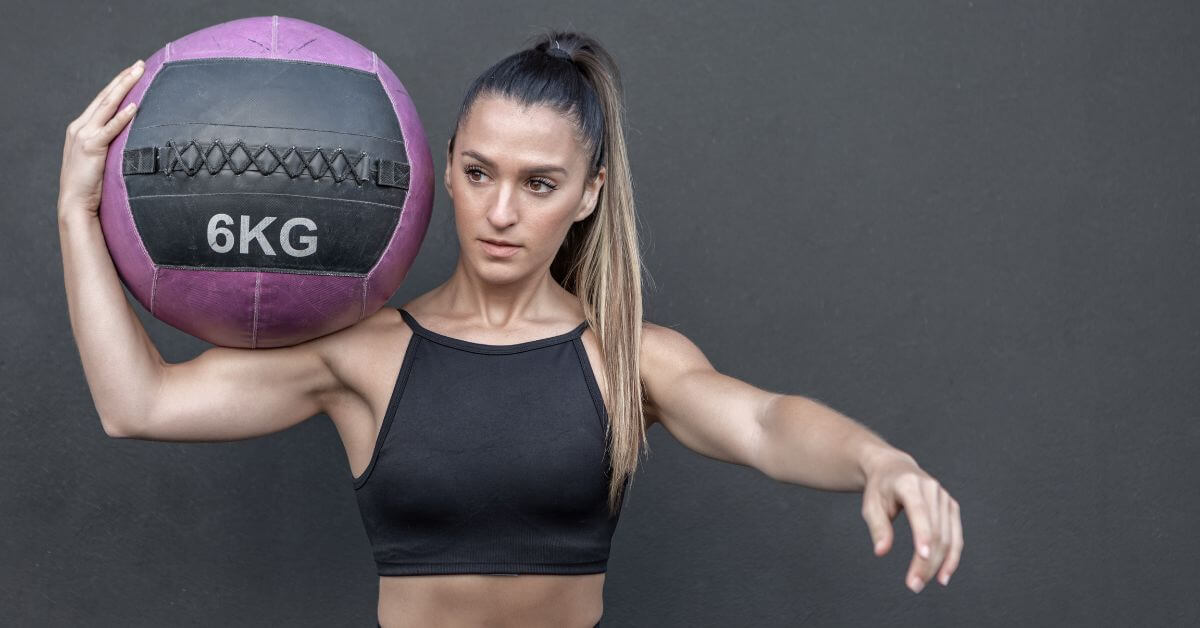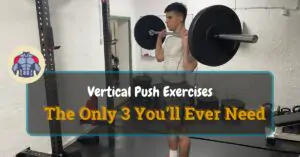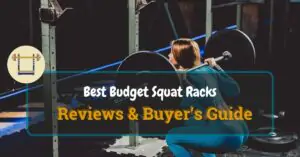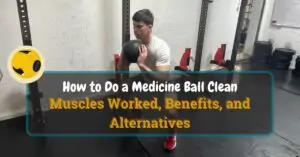Advanced functional training exercises have a basic movement like those for beginners but are more complex.
Table of Contents
ToggleFunctional workouts teach your body to function as a whole compared to just working out individual components.
This method of whole-body training has numerous positive benefits.
Start Building Your Dream Body Today
Ready to elevate your fitness game without falling into the trap of dull, repetitive routines that just don’t deliver? Imagine sculpting your ideal physique and boosting your health, all while still enjoying life’s pleasures, like those irresistible weekend getaways and your aunt’s legendary cheesecake. With our online fitness and nutrition coaching service, you don’t have to compromise. Dive into a personalized fitness journey that blends perfectly with your lifestyle, not against it. Book your completely free discovery consultation today, and take the first step towards a transformation that doesn’t require giving up the joys of life.

“I was skeptical about online fitness coaching, but Functional Body Savage completely changed my perspective. Vanja and Radomir’s personalized approach and attention to detail have helped me achieve goals I never thought possible. I’m stronger, more confident, and grateful for their guidance.”
Emily Thompson, San Francisco, CA
Learn More About Our Online Coaching ServiceWhat Is Advanced Functional Training?
Advanced functional training is a type of training for more experienced exercisers.
When your basic training regimen is over, it is time to transition to equipment-based routine workouts.
The last step towards mastering the movements is to train independently and efficiently.
We will require fitness equipment for this series of exercises, including medicine balls, dumbbells, and more.
List of Advanced Functional Exercises
Here is a list of 9 advanced functional exercises you should include in your training program.
1. Single-Leg Squat
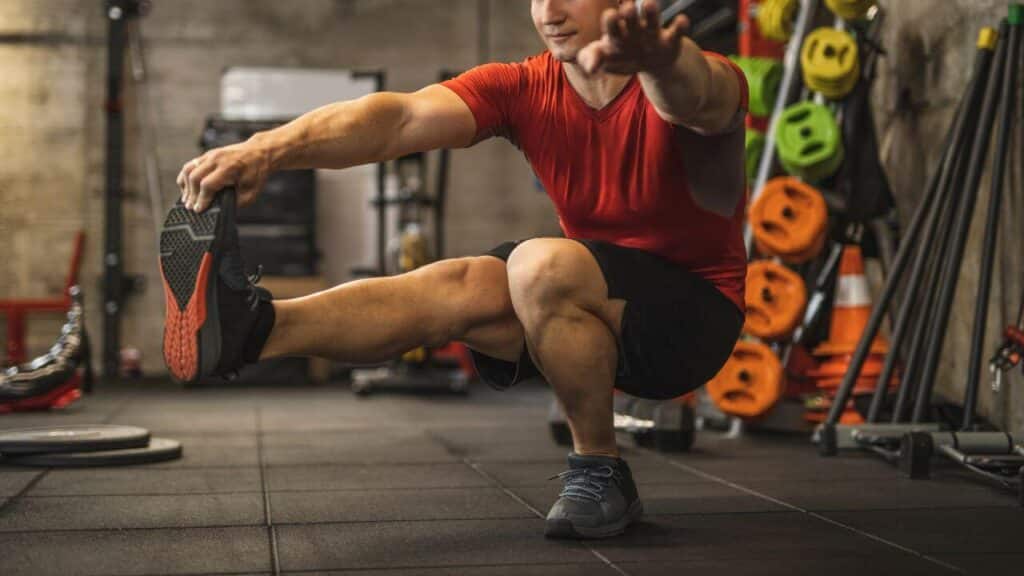
Single-leg squat is a squat performed on one leg. The hips, quadriceps, hamstrings, gluteal muscles, calves, and other supporting muscles like the abdominal muscles are all engaged in a single-leg squat.
By doing this exercise, you can improve your flexibility, balance, coordination, and core strength.
How to Perform a Single-Leg Squat
- Start by placing your right foot forward. Raise your left leg straight and just in front of your torso.
- You could begin by bending your left knee and maintaining an elevated left leg.
- Throughout the exercise, keep your torso raised and your core tight. As you lower yourself into a squat stance, start to drive your hips back.
- To stand back up, contract your glutes as you push off with your right foot.
- Perform 4 to 8 reps on this side before switching to the left, then swap the leg.
2. Sled Push
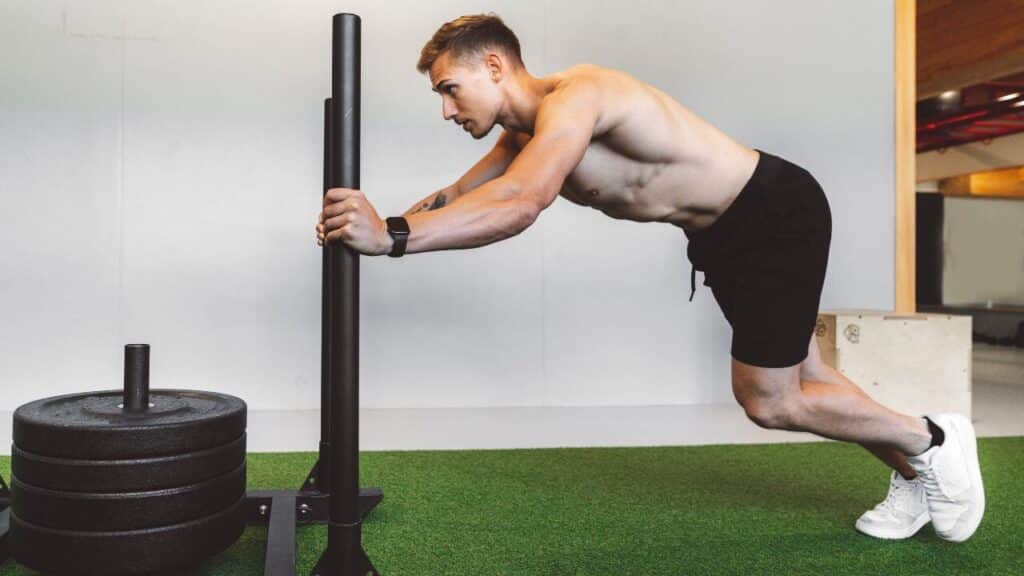
Sled push is a full-body exercise that builds strength, power, and speed while enhancing performance and burning calories.
Sled push will work both upper and lower body muscles when performed correctly.
How to Perform a Sled Push
- Grab the poles with a high-grip hand position while standing behind the sled.
- Push the sled as quickly as possible by contracting your core muscles and using your leg force.
- Moving the sled ahead requires you to extend your hips and knees. Your foot position should match how you would typically run.
3. Medicine Ball Slam
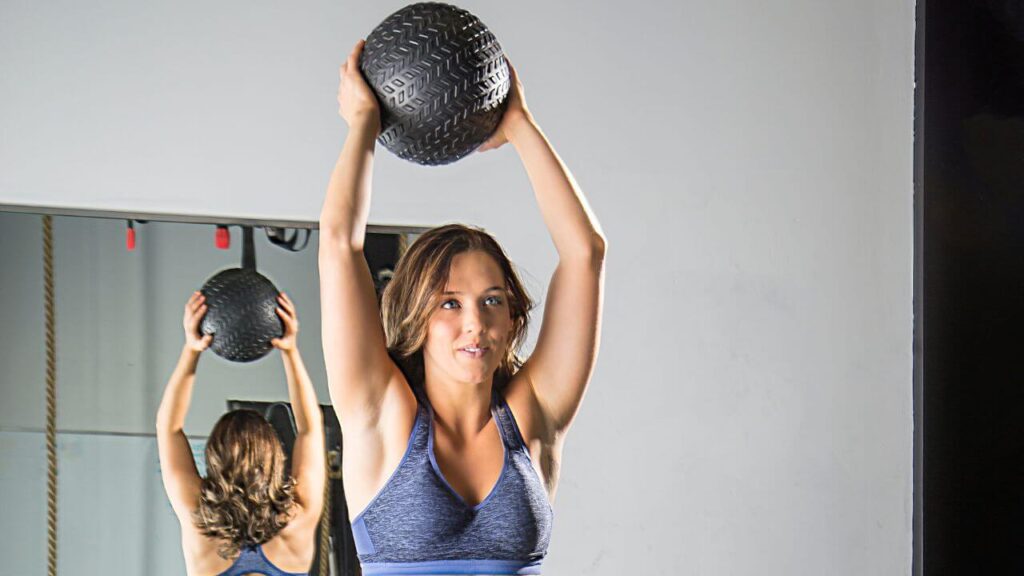
Medicine ball slam is a fantastic upper-body plyometric exercise that can improve overall power and strength. Medicine ball slams are an exercise that can help you build multidirectional core strength.
Medicine ball slams work your complete body, not just your arms, although they include throwing.
Consider medicine ball cleans as well for improving explosive and functional strength.
How to Perform a Medicine Ball Slam
- Holding a medicine ball at chest level is recommended.
- Stand with your knees slightly bent and your feet hip-width apart.
- While lifting the medicine ball onto your toes, raise it above your head.
- Bend your hips and knees as you slam the ball to the ground.
- Lower your legs into a quarter squat stance as you slam the medicine ball.
- Reach for the floor to pick up the medicine ball.
4. Kettlebell Turkish Get-up
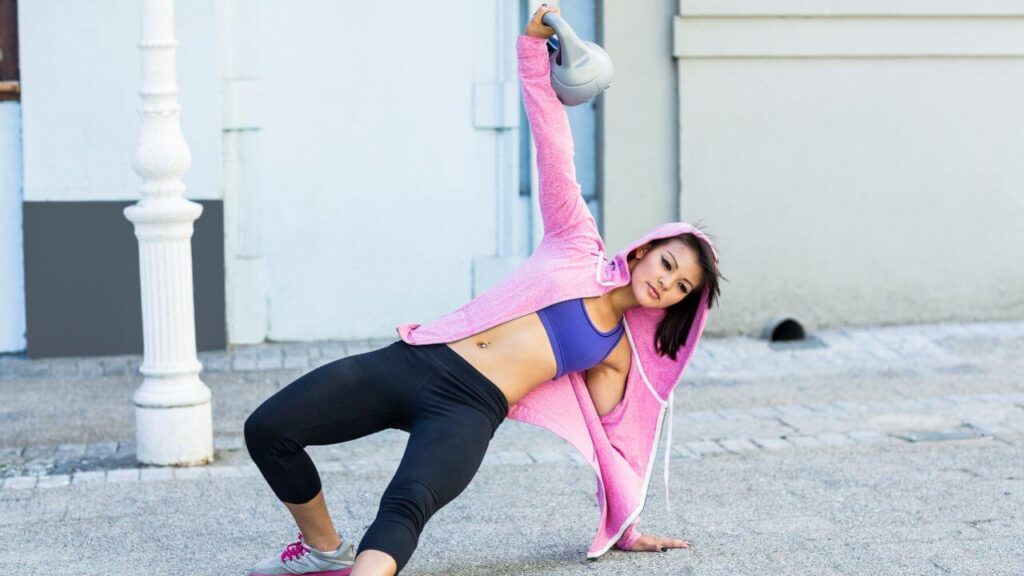
Kettlebell Turkish get-up is a demanding exercise that strengthens the core and stabilizes the entire body.
More significantly, Turkish kettlebell get-up is an exercise that helps improve your core and establishes a solid foundation for a movement that you can use for various other activities.
How to Perform a Kettlebell Turkish Get-up
- On the ground, lie flat on your back. By extending your elbow, lift a kettlebell to its highest point. On the same side as the kettlebell, flex the knee.
- Pivot to the opposing side while keeping the kettlebell locked out. To propel your body into a lunge position, use your non-working arm.
- Self-propelled into a seated position by using your free hand. Continue the motion until you can stand up. Slowly rise and turn to face the kettlebell.
- Reverse the move, then return to the beginning position. Repeat.
5. One-Arm Kettlebell Snatch
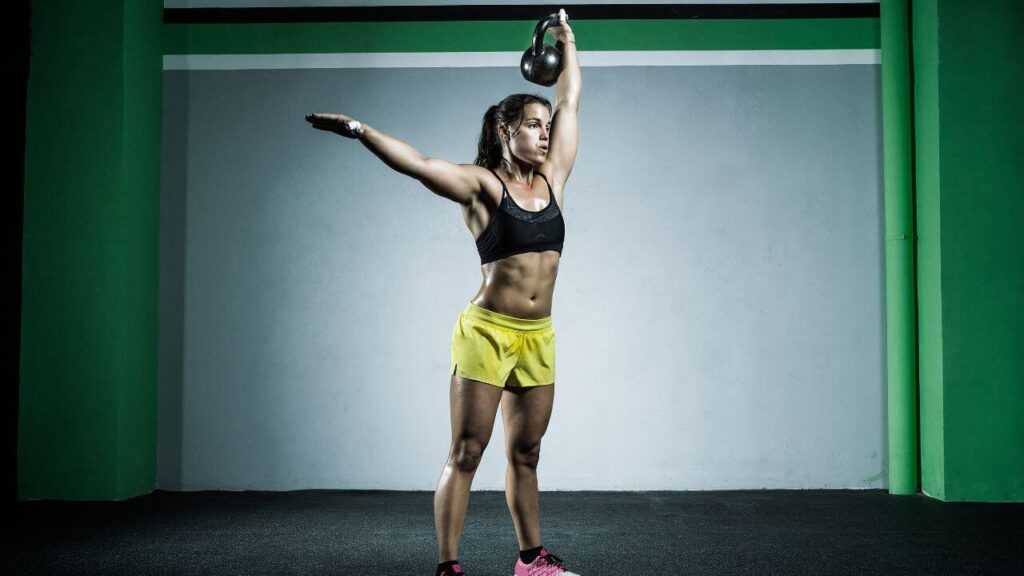
One-arm kettlebell snatch is an exercise that works the glutes, hip flexors, shoulders, lower back, triceps, upper back, and lower traps.
How to Perform a One-Arm Kettlebell Snatch
- Hold a kettlebell with an overhand grip while standing in a half squat with your feet slightly wider than shoulder-width apart.
- So that the kettlebell is between your legs, let your arm swing freely in front of your body.
- Explode up out of the squat and drive the kettlebell up overhead. Rotate your hand when it approaches your shoulders and keeps punching up. Keep your arm straight as you directly overhead the kettlebell.
- Return to the starting position after pausing.
6. Pallof Press
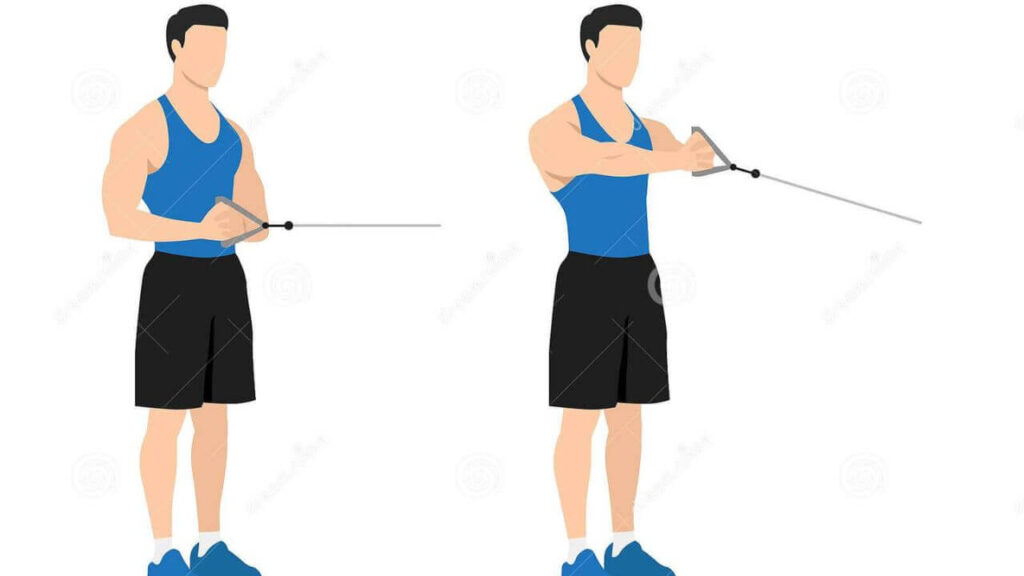
Pallof press is an anti-rotation hold exercise that is fantastic for building a strong core. In this workout, you press a resistance band or wire out and back while holding it in front of your body.
Your core fights against the stress as it pushes you toward the anchor point to keep your torso front on.
How to Perform a Pallof Press
- Hold the handle or band with both hands while standing parallel to the cable machine or the anchor point of the resistance band.
- As you slowly press out, ensure your body is front-on and your hands are in the middle of your chest.
- Repeat while bringing your hands slowly back to your chest.
7. Battling Ropes
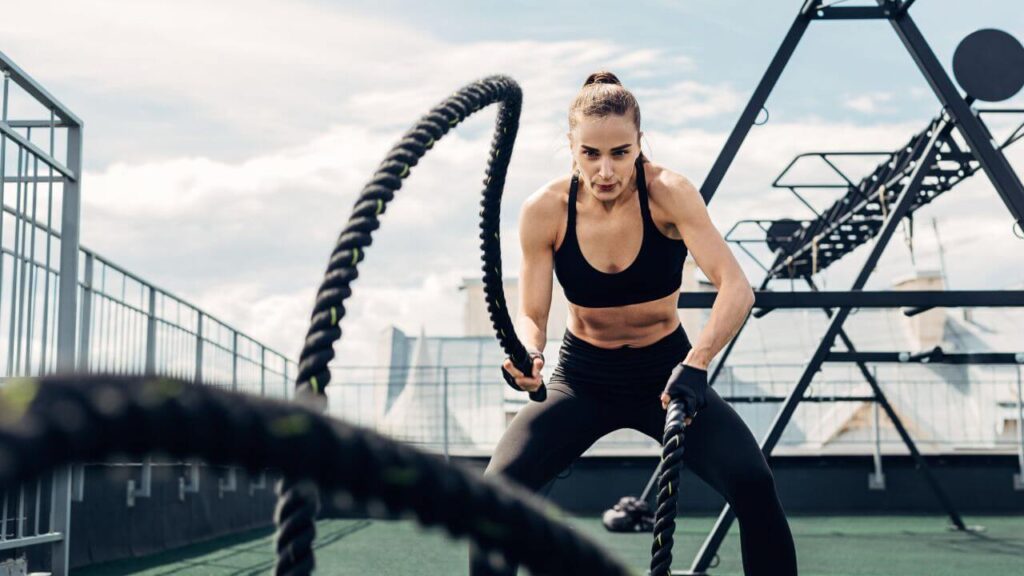
Battling ropes are an exciting and effective training gear that may completely change your conditioning and even help you gain some strength simultaneously.
The freedom to engage more than one muscle group at once is one of the best things about these exercises. These exercises are meant to be high-intensity and require full-body participation.
Depending on your regimen, you may work your back, chest, legs, and core in addition to your arms.
How to Perform a Battling Ropes
- It is best to stand with your feet hip-width apart, holding a battle rope in each hand.
- Create a wave motion through both ropes by starting to raise and lower the ropes one at a time.
- One at a time, move the ropes swiftly and smoothly.
8. One-Arm Dumbbell Bench Press
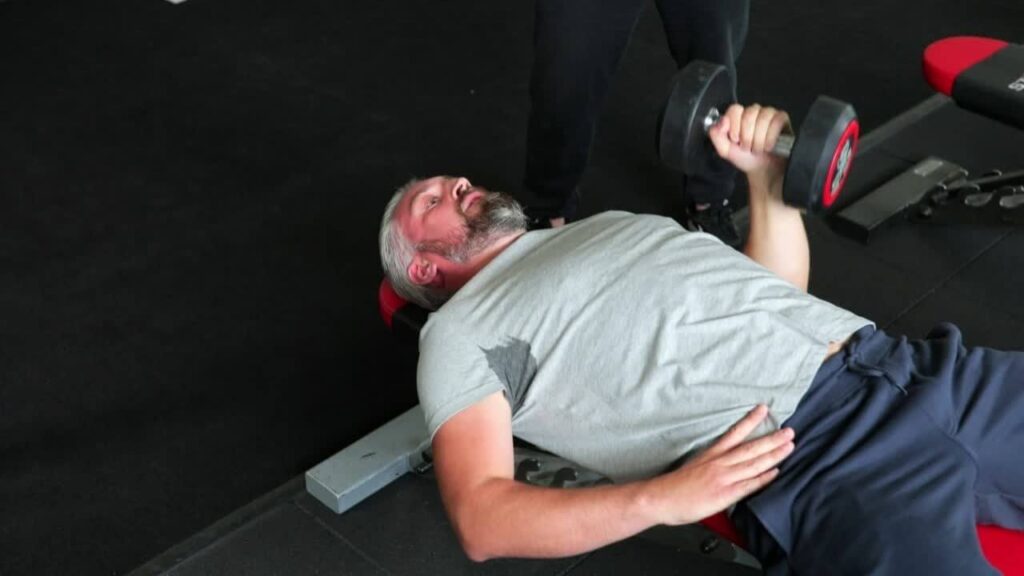
One-arm dumbbell bench press is a variation of the dumbbell bench press, which requires you to lift one arm at a time.
Because your body must fight the impulse to rotate on the bench, it demands balance and stability more than a dumbbell bench press.
These benefits can raise your muscle-building response, develop unilateral upper body strength, enhance core stability, and increase your barbell bench pressing strength.
How to Perform a One-Arm Dumbbell Bench Press
- Place a dumbbell on your thigh while seated on a bench, then raise it to your shoulder. Slowly recline on the bench while maintaining a neutral grasp on the weight at your shoulder.
- Put your feet firmly on the ground, slightly arch your back, and draw your shoulder blades inward.
- Squeeze your core
- Push the dumbbell overhead
- Return the dumbbell to your shoulder by lowering it gradually.
9. Unilateral Exercises
Unilateral exercises are single-arm or single-leg movements. Include unilateral workouts in your training regimens for the main advantage of having the exerciser use both sides of the body equally.
By doing this, you can aid in preventing injuries [1], identifying and treating muscular imbalances, improving balance, utilizing the core muscles, and overtraining or excessive usage of the dominant side.
You can focus on developing the muscles on each side of the body independently by splitting the body into its four sections.
Examples of unilateral exercises are:
- Lateral box step down
- Dumbbell split squat
- Single-arm dumbbell floor press
- Single-arm bent over dumbbell row
- Single-arm overhead press
“Single leg strength is specific and cannot be developed through double leg exercises.” – Michael Boyle, Strength and Conditioning and Strength Training Consultant
Related Articles:
- 31 Functional Exercises for Superior Strength and Mobility
- Functional Training 101: Ultimate Guide to Next-Level Fitness
How to Start With Advanced Functional Training?
If you are familiar with basic functional training activities, a fantastic place to start is with advanced functional training.
Staying fit and active for daily tasks is made possible by doing this.
You can see in the exercises above that you only need a few items to complete advanced functional training.
Which of these nine exercises is your favorite? Let us know.
Start Building Your Dream Body Today
Ready to elevate your fitness game without falling into the trap of dull, repetitive routines that just don’t deliver? Imagine sculpting your ideal physique and boosting your health, all while still enjoying life’s pleasures, like those irresistible weekend getaways and your aunt’s legendary cheesecake. With our online fitness and nutrition coaching service, you don’t have to compromise. Dive into a personalized fitness journey that blends perfectly with your lifestyle, not against it. Book your completely free discovery consultation today, and take the first step towards a transformation that doesn’t require giving up the joys of life.

“I was skeptical about online fitness coaching, but Functional Body Savage completely changed my perspective. Vanja and Radomir’s personalized approach and attention to detail have helped me achieve goals I never thought possible. I’m stronger, more confident, and grateful for their guidance.”
Emily Thompson, San Francisco, CA
Learn More About Our Online Coaching ServiceReferences:
- https://www.ncbi.nlm.nih.gov/pmc/articles/PMC9331349/

